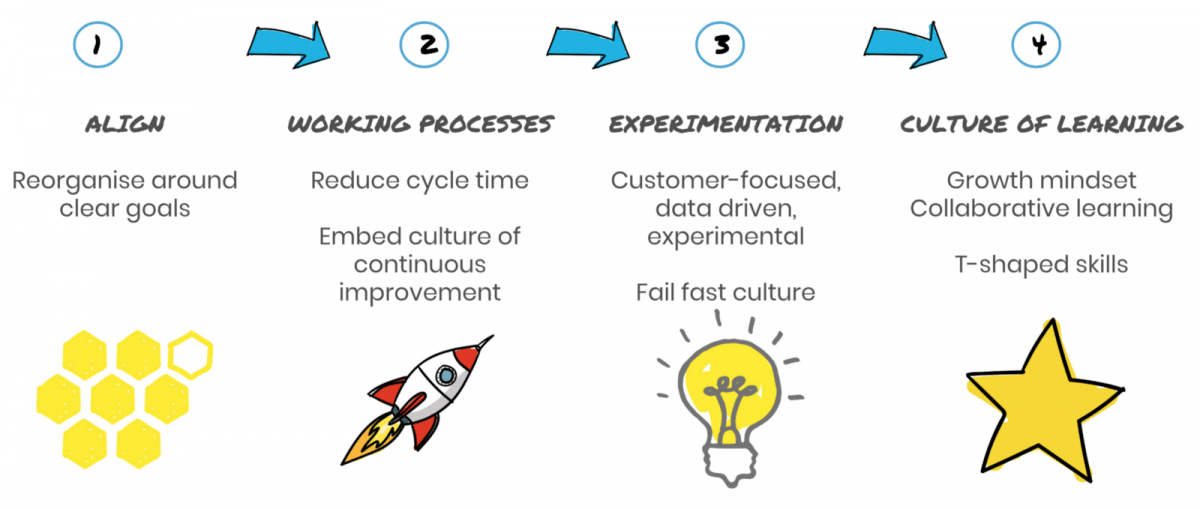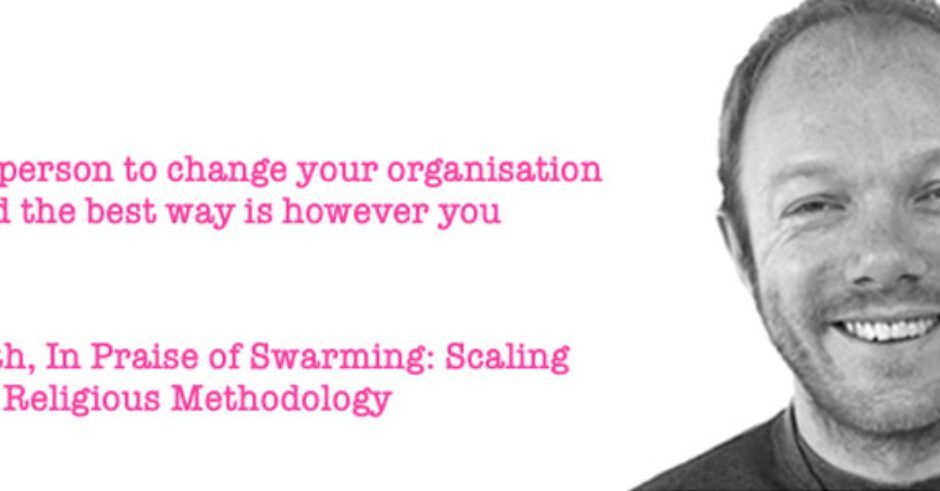In order to organise my own ideas, I realised it would be helpful to have a clear vision for what I wanted to achieve, together with measurable outcomes. I began with a mission statement:
“I want to design a tailored system of work that optimises the entire organisation, allowing Moonpig to innovate and move fast at scale, whilst still ensuring it is a place that people love to work.”
How will I know if we have succeeded?
The outcomes I wanted to achieve could neatly be summed up in three words: better, faster and happier. For this, I am indebted to Jonathan Smart. I first heard Jon speak at the excellent SEACON conference, when he described his approach to agility at Barclays. He explained how they no longer used the “A” word. Instead of talking about being Agile, they talked about being better, faster, cheaper and happier. I think this is a brilliantly succinct way of capturing the benefits of being lean and agile.
I have taken this a step further and reduced it to 3 words which represent the 3 outcomes I wanted to achieve:
- Better = better outcomes leading to increased ROI
- Faster = reduced cycle time across all value streams
- Happier = higher employee engagement
How?
Developing a plan
This is essentially what I thought of as my strategy — how I planned to go about delivering these outcomes.
Getting better
I believed we would get better by:
- Embedding a customer-focused, data-driven, experimental approach to minimise wasted investment.
- Understanding where we create value and reduce time wasted on low-value output.
- Increasing innovation through the collaboration of people with different skills and expertise.
Getting faster
I believed we would get faster by:
- Aligning relevant people around key outcomes and removing conflicting priorities and dependencies.
- Leveraging lean working practices — visualising work, reducing work in progress and focusing on finishing.
- Championing a culture of collaboration and cross-functional working where team success comes before individual glory.
- Embedding a continuous improvement mindset, seeking to constantly optimise our working processes.
- Empowering and supporting teams to self-organise, removing dependencies and bottlenecks around senior management.
Getting happier
I believed we would get happier by:
- Developing a safe-to-fail environment where people can take risks.
- Ensuring our teams have clear goals and are supported to achieve them.
- Creating a culture of autonomy where teams are empowered to use their collective skills to deliver outcomes.
- Encouraging a growth mindset and making learning a central part of our working life.
The “Roadmap”
A common misconception about agile is that it involves no planning. This is nonsense. Agile involves a lot of planning, but it advocates changing a plan as you gain more information. There are various reasons you should have a plan. Firstly, you’re more likely to succeed if you know how you’ll go about it. Secondly, you will win more confidence and influence from those around you if you have a clear plan.
When I first started exploring the possibility of business agility, I spent a lot of time with our commercial and marketing functions. I realised fairly quickly that there were plenty of opportunities to introduce lean and agile working practices, but that it would be very difficult to make them work within the existing team structure.
I also realised from my experiences with product development teams, that there is a sensible order in which to introduce improvements.

- Alignment comes first — aligning people around goals and outcomes reduces dependencies and conflicting priorities and thus immediately delivers increased speed. Secondly, it provides a much easier context in which to introduce lean and agile working practices because it enables better collaboration and communication.
- Having aligned teams effectively, the next step is to support them in developing the practices and processes that will enable them to optimise the efficiency of their workflow and reduce time to deliver value. Introducing a healthy process also reduces chaos and provides structure and clarity which helps create a happier working environment. Reducing chaos buys a lot of faith and goodwill, and this helps pave the way for more change. Improved delivery capability also builds confidence and trust within the leadership team, and this, in turn, supports the safe-to-fail environment which is critical for bold experimentation.
- Experimentation comes after speed simply because, in order to fail fast, you need to be able to deliver fast!
- To a degree learning happens in parallel with all these steps — learning how to work differently, learning from experiments, learning about your customers and learning from one another. However, to really double down and build a culture of lifelong learning you need people first to understand the benefits of learning and developing a growth mindset, and secondly, they need to have time to learn. Agile and lean working practices provide a way of working at a sustainable pace. A healthy system of work will have some slack and that provides time for self-learning. In addition, introducing the concept of continuous improvement and adopting an experimental approach helps to challenge the fixed mindset. At this point, you can accelerate learning initiatives and start introducing the concept of t-shaped skills.
Sharing your vision and strategy
One regret I have is that, whilst I developed a clear vision and strategy, I didn’t share it with the leadership team. In hindsight. I suspect that defining clear, measurable outcomes, and explaining how we would reach them would have helped de-mystify the process of “being agile”. It would have provided vital education and helped them understand how they could effectively support the changes. Whilst I was privileged to have great support from the leadership team, I think sharing the approach could have made the process of change much easier for them.
What’s next?
So by now, you have hopefully understood why change was needed, what I wanted to achieve and how I planned to go about it. In the subsequent posts, I’ll start describing in detail how the plan was put into action.
If you missed it, you can read Part 1 and Part 2 here.


